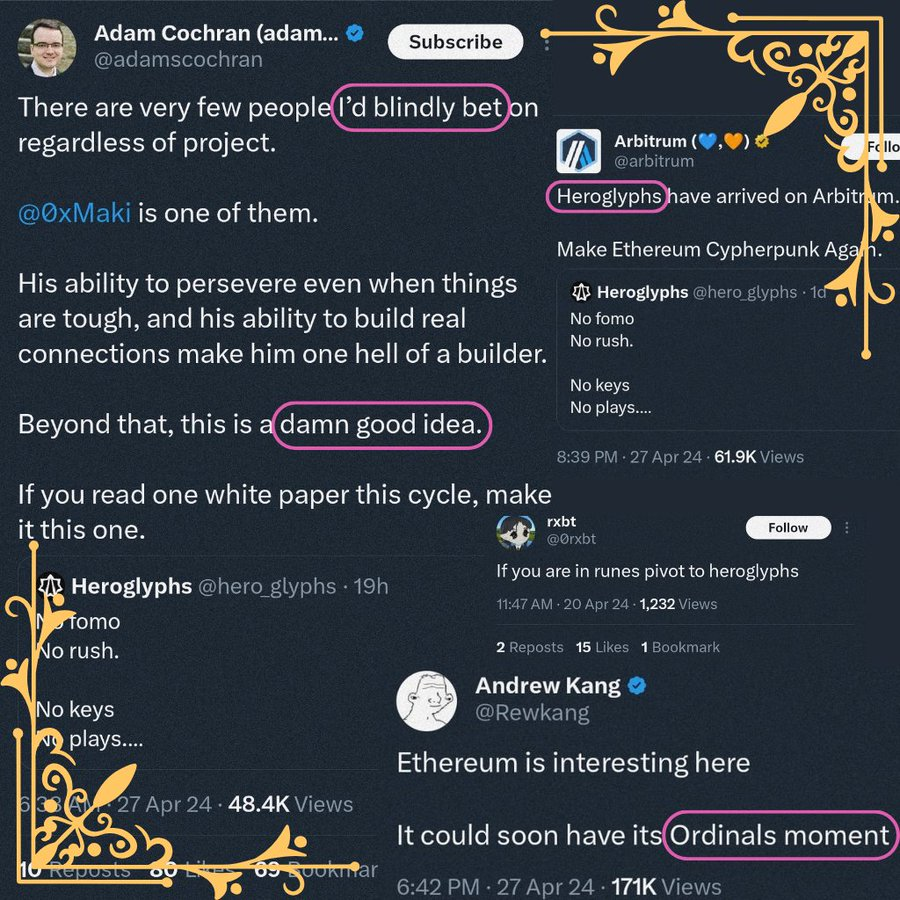HeroGlyphs aims to motivate people to become complete validators by giving them the ability to exclusively create tokens that only they can create.
Author: ELI5 of TLDR
Translator: DeepTechFlow
Introduction
While the inscription/rune project of Bitcoin has attracted a lot of attention, the HeroGlyphs project on the Ethereum platform is opening up another unique token opportunity. The project not only challenges the traditional token minting model but also contributes new ideas to the decentralization of Ethereum.
The HeroGlyphs project introduces the so-called "elite tokens" by giving complete validators exclusive token minting rights. These tokens are different from meme coins on the market, as they represent the actual value of network security and technical contributions.
As Ethereum gas prices decrease and are expected to return to ETH, the HeroGlyphs project may provide a new perspective.
The following is the full translation.
I mean, would you rather buy tokens created by the king or tokens created by the farmer?
This article will briefly explain HeroGlyphs, which I think will bring better things than runes.

HeroGlyphs is a new protocol on the Ethereum blockchain, not designed for us ordinary cryptocurrency enthusiasts, but for complete validators. Validators are the people who keep Ethereum "alive."
HeroGlyphs allows complete validators to create (or mint) their own special tokens, which only they can create.
The quantity will not be large, and they will be "elite tokens," not some random meme coins or similar things. They have deeper meaning and greater intent.
Ethereum faces the risk of centralization, and in an industry based on decentralization, centralization is not a good thing, because if there are three major validators and they have the majority of "power," then we may encounter problems.
As liquidity staking becomes more popular, we have many "economic validators" who do not actually contribute to network security. These "economic validators" only stake ETH for rewards, and the staked ETH is managed by a single protocol.
Even if these protocols have good intentions, centralization is not a good thing. Centralization is centralization, and it brings multiple risks.
Therefore, HeroGlyphs is a protocol aimed at motivating people to become complete validators to decentralize the validator environment as much as possible.
Currently, it seems less profitable to become a complete validator if you do not have a large amount of ETH. Having a large amount of ETH increases the chances of being selected to confirm blocks and receive rewards.
Although the entire process of selecting validators is random, holders of a large amount of ETH can create multiple validator clients to increase their chances of being selected. Therefore, in practice, liquidity staking protocols and large validators centralize Ethereum.
Now it's the turn of the HeroGlyphs project created by crypto masters, which aims to motivate people to become complete validators by giving them the ability to exclusively create tokens that only they can create.
It's like having tokens created by those who control the network and ensure its continuous operation. I mean, currently anyone can create a token. It actually only takes a few clicks of the mouse.
But HeroGlyphs has opened up a new path for token creation: elite tokens created by complete validators—those who truly protect network security.
HeroGlyphs hopes to increase additional sources of income based on the speculation and Degen trends of cryptocurrencies.
Everyone comes to the cryptocurrency industry for speculation. How many of you have minted HeroGlyphs tokens but do not understand them? Don't be shy, admit it, we are all struggling here.
Okay, but how does all this work?
A randomly selected proposing validator can "engrave" (just like runes/Ordinals) some short data into the block. It can be anything, but up to 32 bytes.
The HeroGlyphs protocol consists of two parts: one part for encoding information and the other part for translating information.
It's difficult to fit all the information needed to create tokens into 32 bytes, so we have to establish some "identifier symbols."
These "identifier symbols" will be short markers that CM (validators with specific permissions) can rent and use to mint more tokens (and do other things related to token management and creation).
Yes, rent, not purchase. It should operate based on the Herberger tax principles.
You rent it based on the value you think it has and pay that amount within the specified time interval.
Do you think such a marker is worth 5 ETH? No problem. But if someone else thinks it's worth more and is willing to pay more, then say goodbye to your marker.
But how will validators be rewarded? According to the project's whitepaper, all complete validators will receive equal rewards, and minting rewards will be evenly distributed.
This is an interesting approach, interesting for us ordinary crypto investors and the entire Ethereum network, as it will enhance its security.
Not long ago, Ethereum's co-founder Vitalik wrote an article about meme coins and their potential.
By investing in NFT/Meme of Ethereum validators, you will contribute to a better decentralized future. Complete validators are heroes, but so are you!
免责声明:本文章仅代表作者个人观点,不代表本平台的立场和观点。本文章仅供信息分享,不构成对任何人的任何投资建议。用户与作者之间的任何争议,与本平台无关。如网页中刊载的文章或图片涉及侵权,请提供相关的权利证明和身份证明发送邮件到support@aicoin.com,本平台相关工作人员将会进行核查。




